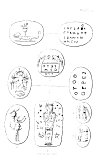
Sacred Texts Gnosticism Index Previous Next
Buy this Book at Amazon.com


The Gnostics and Their Remains, by Charles William King, [1887], at sacred-texts.com

Click to enlarge
Plate H
1. Tortoise lying upon the lotus, which springs out of the back of a crocodile. The unexplained legend of the reverse occurs again in connection with an analogous design--a vulture-headed winged Genius, seated on the back of a double-headed crocodile, published by Walsh (No. 13) in his 'Coins, Gems, &c., illustrating the Progress of Christianity.'
2. The Ark of the Covenant, apparently copied from the "Altar of Lyons," that so common device of the brass coins of Tiberius. The engraver of this late Roman gem had not studied the minute description of the Ark, given in the Law. There is a Rabbinical tradition (although savouring too much of Alexandrian philosophy to demand any credit) that the Cherubim placed over it were represented as male and female, in the act of copulation, in order to express the grand doctrine of the essence of Form and Matter, the two principles of all things. When the Chaldeans broke into the Sanctuary, and beheld this most astounding emblem, they naturally enough exclaimed "Is this your God, of whom you boast, that He is such a lover of purity!"
On the side is a blundered attempt at the mystic word, Tetragrammaton,
i.e. the Name of Four Letters,' viz.--Iod, He, Vau, He. For the Names of God, according to the Kabbala, are made up respectively, of Four, Forty-two, and Seventy-four letters. The second explains the motive for the number of sacrifices offered up by Balaam in his fruitless attempt to propitiate the God of the Hebrews; and perhaps may have induced the composers of the Genealogy of Jesus (though working independently of each other) to bring out the same mystic number by curtailing the second series of three of its kings.
3. A doubly-winged and doubly-armed Power, holding four Egyptian sceptres, and standing on a coiled serpent, enclosing a Holy Name. The legend is a transliteration of the Hebrew for "Light of Lights." Another form of such transliteration is given by Caylus ('Recueil d’Antiquités,' vi. Pl. 21), σρωοριονσ, reading from the end backwards; cut for reverse to a coiled serpent enclosing various sigla.
4. Thoth's baboon, bearing on his head the Solar disk, in the attitude of adoration. The reverse bears ΗΝΑ-ΜΕΡΩ, sometimes written ΜΑΠΩ-ΗΝΙ, "Enlighten my eyes!" whence we may suspect this very common type to be no more than an amulet against ophthalmia.
5. This gem is given here as a good specimen of a type of which great numbers are to be met with, although its whole conception, and the vague symbols in the field--the Solomon's Seal, celestial globe, etc., entirely out of the antique taste, refer its creation to the fancy of mediæval quacks and astrologers. Was the figure suggested by the idol "in the shape of an Old Man," with whose worship the Templars were so persistently charged? The present example, belonging as it does to the original Praun Cabinet, must have been executed before the beginning of the seventeenth century.
6. The outline of the human figure filled up with "Holy Names," and thereby representing Adam Kadmon, "the Primitive Man" of the Kabala. The finest example of this curious design, and in which the letters are the most clearly defined, is the one Caylus gives (l.c. pl. 22), which has been cut by a later hand on the reverse of a Lion passant, in the Persian style.
7. The Baboon adoring a Triangle, Egyptian symbol of the Moon, elevated upon a column bearing an inscription. The fact that the Pythagoreans (who avowedly got their whole system from Egypt) symbolised Athene by the triangle, lends strength to the idea that the Attic goddess was in her origin merely the expression of the Lunar Power.